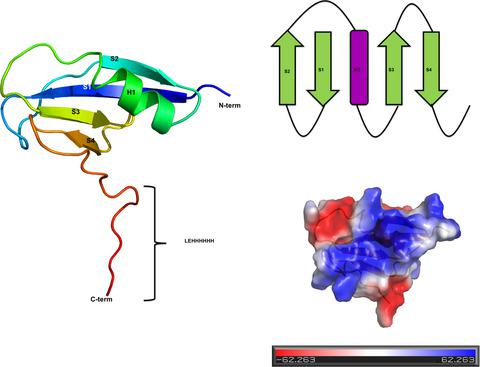当前位置:
X-MOL 学术
›
FEBS Open Bio
›
论文详情
Our official English website, www.x-mol.net, welcomes your feedback! (Note: you will need to create a separate account there.)
A high‐resolution (1.2 Å) crystal structure of the anti‐CRISPR protein AcrIF9
FEBS Open Bio ( IF 2.6 ) Pub Date : 2020-09-29 , DOI: 10.1002/2211-5463.12986 Gi Eob Kim 1, 2 , So Yeon Lee 1, 2 , Hyun Ho Park 1, 2
FEBS Open Bio ( IF 2.6 ) Pub Date : 2020-09-29 , DOI: 10.1002/2211-5463.12986 Gi Eob Kim 1, 2 , So Yeon Lee 1, 2 , Hyun Ho Park 1, 2
Affiliation

|
Prokaryotic adaptive immunity by CRISPR‐Cas systems, which confer resistance to foreign genetic elements, has been used by bacteria to combat viruses. To cope, viruses evolved multiple anti‐CRISPR proteins, which can inhibit system function through various mechanisms. Although the structures and mechanisms of several anti‐CRISPR proteins have been elucidated, those of the AcrIF9 family have not yet been identified. To understand the molecular basis underlying AcrIF9 anti‐CRISPR function, we determined the 1.2 Å crystal structure of AcrIF9. Structural and biochemical studies showed that AcrIF9 exists in monomeric form in solution and can directly interact with DNA using a positively charged cleft. Based on analysis of the structure, we suggest part of the anti‐CRISPR molecular mechanism by AcrIF9.
中文翻译:

抗 CRISPR 蛋白 AcrIF9 的高分辨率 (1.2 Å) 晶体结构
CRISPR-Cas 系统的原核适应性免疫赋予对外来遗传元件的抗性,已被细菌用于对抗病毒。为了应对,病毒进化出多种抗 CRISPR 蛋白,这些蛋白可以通过各种机制抑制系统功能。尽管已经阐明了几种抗 CRISPR 蛋白的结构和机制,但尚未确定 AcrIF9 家族的结构和机制。为了了解 AcrIF9 抗 CRISPR 功能的分子基础,我们确定了 AcrIF9 的 1.2 Å 晶体结构。结构和生化研究表明,AcrIF9 以单体形式存在于溶液中,可以使用带正电荷的裂缝直接与 DNA 相互作用。基于对结构的分析,我们提出了 AcrIF9 的部分抗 CRISPR 分子机制。
更新日期:2020-12-03
中文翻译:

抗 CRISPR 蛋白 AcrIF9 的高分辨率 (1.2 Å) 晶体结构
CRISPR-Cas 系统的原核适应性免疫赋予对外来遗传元件的抗性,已被细菌用于对抗病毒。为了应对,病毒进化出多种抗 CRISPR 蛋白,这些蛋白可以通过各种机制抑制系统功能。尽管已经阐明了几种抗 CRISPR 蛋白的结构和机制,但尚未确定 AcrIF9 家族的结构和机制。为了了解 AcrIF9 抗 CRISPR 功能的分子基础,我们确定了 AcrIF9 的 1.2 Å 晶体结构。结构和生化研究表明,AcrIF9 以单体形式存在于溶液中,可以使用带正电荷的裂缝直接与 DNA 相互作用。基于对结构的分析,我们提出了 AcrIF9 的部分抗 CRISPR 分子机制。


























 京公网安备 11010802027423号
京公网安备 11010802027423号